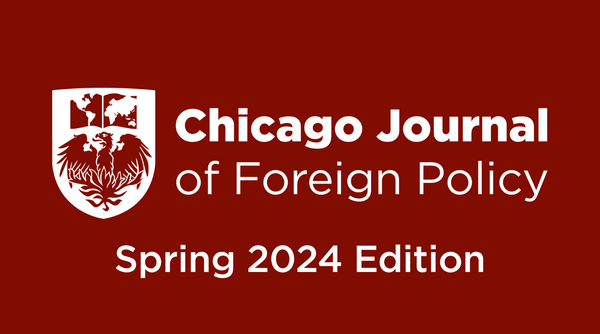Reactions to Extreme Symbolic Terrorism: the Cases of ISIS and al-Qaeda

by HUGO BARRILLON, ’21
All terrorist attacks are not created equal. Some terror attacks bring about global campaigns against terror organizations, while others just bring about localized, national punishment within a judicial system. The 9/11 attacks and the 2014 ISIS beheadings brought about incredibly strong reactions from the victim country whereas events such as the Boston Marathon Bombings did not. This paper analyzes the role of symbolism in terrorist attacks and how it affects the strength of reaction by victim countries. Focusing on the 2014 ISIS beheadings and the 9/11 al-Qaeda attacks, this paper explains why attacks of different scale perpetrated by different organizations can provoke a similarly strong reaction on the part of the victim. I argue that there is one salient element which the two attacks have in common: symbolism. The 2014 ISIS beheadings and the 9/11 attacks on the World Trade Center were both highly symbolic acts of terrorism, which represented existential threats to the American way of life and political system. The highly symbolic nature of these two attacks directly led to hard-line reactions from the United States as retaliation. Thus, individuals and terrorist organizations who engage in terrorism with marked symbolism can expect strong reactions from the governments threatened, regardless of the scale of the attack or the particular identity of the organization.
In Arie Perliger’s How Democracies Respond to Terrorism, symbolic power is defined and the importance of symbolism in terrorism is emphasized. Perliger explains that symbolic power is the ability to convince others that a group’s perception is a reality, and empower supporters to commit violent acts as a means of obtaining values or policies opposed to a nation’s ethos.[1] This is the definition of symbolic power that will be used in this paper; it is the threat that terrorists pose to a country due to their ability to upend perceptions of the world, and thus change a state’s way of life. Perliger emphasizes that symbolic power is more effective in evoking a strong state response than physical violence because it directly targets the processes and aims of government. I will use the cases of 9/11 and the 2014 ISIS beheadings to demonstrate that this is the reason for which the United States enacted hard-line military responses in Afghanistan as well as Syria and Iraq.
In Andrew Bacevich’s The War on Terror Properly Understood, he argues that the ‘global war on terror’ needs to be more clearly defined.[2] In the process of making this argument, he makes clear that the United States’ purported war on terror was directly caused by the events of 9/11.[3] Further, in Hussein Banai’s The Future of ISIS, he explains that the emergence and expansion of ISIS in 2014 – for which the beheadings are a symbol – is the direct cause of the United States’ coalition’s action against ISIS.[4] Both of these pieces demonstrate a direct link between the two symbolic attacks and the United States’ response which followed suit. This paper will go a step further and present evidence to prove that the symbolic aspects of these attacks are the most important reasons for which such strong military action was undertaken in response. These pieces, along with Perliger’s, are a starting point on which I base my argument.
Al-Qaeda and ISIS were chosen for this paper due to their difference in size, capability, and aim. Indeed, scholars have argued that ISIS is not even a terrorist organization in the traditional meaning of the term.[5] ISIS is more accurately a “pseudo state” with tens of thousands of fighters, land control, and military capability whereas al-Qaeda is more of a traditional terrorist organization that does not hold territory, cannot confront military forces, and has a much smaller core organization.[6] While al-Qaeda attacks civilians in order to further their ideological goals, ISIS attacks civilians, militaries, and journalists in order to gain control of land and spread ideology. Although both organizations employ terrorism as a means of messaging, the ways in which they are structured and go about daily function are quite different.
Thus, it is not surprising that 9/11 and the 2014 beheadings are also markedly different attacks. Most prominently, the two attacks differ in scale; while 9/11 caused the deaths of nearly 3,000 people, the beheadings have caused the deaths of approximately 300 over the course of three years, only two of which were American citizens. While both are tragic losses, there is a large difference in the impact of the two attacks on American life. Further, although both were dramatic, 9/11 weaponized a commercial airliner and destroyed iconic towers in the largest American city. In comparison, the ISIS beheadings were primitive, using knives and swords to behead kneeling people. While true that the responses for each attack were slightly different in scale, the two attacks provoked an unusually intense level of response from the United States. This paper posits that this is due to their symbolism, and that had the attacks been less symbolic, the reaction would have been different.
Al-Qaeda’s September 11th attacks were the epitome of symbolic terrorism. This attack ties directly into Perliger’s idea of a threat to “acceptable political and social values and practice.”[7] Both the practices and values of the terrorists were inherently antithetical to American values and practices, at once threatening and provoking the United States. Perliger makes clear that the strongest state reaction will come about in reaction to a threat to a nation’s values, perceptions, and ways of doing things.[8] 9/11 did just that, threatening the United States’ way of life through literal destruction of the World Trade Center and parts of the Pentagon, symbols of economic and political prosperity and stability. This sent a blatant message to the American people that their prosperity and every day comfort was to be threatened by these terrorist organizations, and that values such as life, freedom, and progress were under attack. The attack is considered symbolic because this value-based threat is not tangible or physical yet poses a potential problem for the values and important psychological elements necessary for the United States’ continuing success. Some may argue that the aims of these attacks were to kill rather than send a message. Although partially true, these attacks were more than just losses of American life, they were rife with symbolism and posed a threat to the United States’ order and values in a way which drew international attention and concern. Thus, Perliger – as well as this paper – expect a forceful reaction from the victim country.[9]
The 2014 ISIS beheadings, specifically the beheadings of Steven Sotloff and James Foley, contain a similar degree of symbolism as the 9/11 attacks, despite their difference in scale. In the murders of both James Foley and Steven Sotloff, these journalists are shown kneeling in orange jail jumpsuits – not unlike those used for the prisoners of Guantanamo Bay – while an ISIS soldier stands behind them with a knife in hand.[10] [11] The symbolic power of the beheadings lies in this power dynamic between the captured and the capturer. Americans wearing orange jumpsuits reminiscent of Guantanamo Bay paint the United States as terrorists, and the ISIS soldiers behind them as merely providing retribution for their sins. ISIS positions themselves to be the hero for the disenfranchised rather than terrorists to the West, at once glorifying themselves and demonizing the United States. This symbolism and power dynamic is incredibly potent because it simplifies the moral dilemma of violence against the US government. For those who feel disenfranchised and as if they do not have a voice in American society, this symbolism can be powerful enough to convince them of the United States’ malevolence. Further, as journalists, Sotloff and Foley are responsible for the dissemination of knowledge, informing citizens, and allowing free thought. The killing of these figures is vehemently antithetical to the United States’ national ethos, and therefore presents another value-based threat. Freedom of speech and the press is a fundamental American value, one clearly enumerated in the US Constitution, and any attack on a representative of that value is often met with anger. Finally, despite what some may believe, these murders were too targeted and small-scale for their aim to be physical; their aims must have been symbolic to justify the international publication of such a small-scale attack.
These symbolic attacks subsequently provoked incredibly strong and multi-faceted responses from the United States. In this paper, I will be focusing on Operation Enduring Freedom in Afghanistan as a response to 9/11 and Operation Inherent Resolve as a response to the ISIS beheadings. Scholars can know that these operations were directly caused by each attack due to both their timings and the rhetoric of American leaders. Operation Enduring Freedom (commonly referred to as the ‘War on Terror’) was first brought up in George Bush’s address to Congress on September 20, 2001, 9 days after the attacks.[12] In this address, he says the words “war on terror” and “al-Qaeda” in the same sentence, and at this time, al-Qaeda was only associated with one thing: the September 11th attacks.[13] This demonstrated to the American public that Operation Enduring Freedom was directly provoked by the attacks on September 11th. In the case of Operation Inherent Resolve, the US Central Command released a statement on October 15, 2014 (less than a month after the beheading of Steven Sotloff) explicitly stating that this operation’s goal was to eliminate the threat of ISIS.[14] Around this time, there had been no other major attacks by ISIS, giving way to the assumption that this operation was brought upon by the beheadings. Although there have been attacks and violence committed by ISIS between the beheadings and today, the operation was initiated at a time when it could only have been in response to the beheadings of the two American journalists.
Operation Enduring Freedom in Afghanistan was a strong and complex military operation aimed at ending the Taliban regime in Afghanistan as well as weakening al-Qaeda.[15] The ‘War on Terror’ is the quintessence of a hard-line reaction to terrorism. In fact, it was considered to be the most high-tech military campaign ever conducted by the United States; 60% of the bombs dropped were guided by lasers or satellites, and it is estimated that 75% of the bombs dropped were accurate.[16] Further, in an address to the nation two years into the operation, President Bush explained that “our mission continues. al-Qaeda is wounded, not destroyed” and that “the war on terror is not over,”[17] making clear that the United States would not stop until the threat of al-Qaeda was neutralized. The fact that at the operation’s peak in 2009, the United States had over 142,000 troops in Afghanistan fighting against the Taliban[18] is a testament to the strength of the US response. Operation Enduring Freedom was an enormous, highly advanced, and thoroughly intimidating operation. The response’s statistics alone are enough to demonstrate the power of the United States’ military reaction, and the results only confirm it.
Estimates of terrorist casualties during Operation Enduring Freedom between 2001 and 2014 placed the number between 20,000 and 35,000 deaths.[19] Even on the lower end of the estimate, this is no small number, exemplifying the intensity of the US reaction to al-Qaeda. Even more salient is the United States’ assassination of Osama Bin Laden. Bin Laden was the spiritual leader and head of al-Qaeda, and was incredibly involved with the organization’s operations up until his death.[20] His killing by United States forces used symbolism to combat symbolism and send a clear message to al-Qaeda that no one in their organization was immortal or protected.[21] In many ways, this was a considerable blow to Bin Laden’s organization because of his near godlike status and respect. The results, size, and capabilities of Operation Enduring Freedom are incredibly demonstrative of the force with which the United States responded to 9/11.
The US government’s reaction to ISIS’ beheading of two American journalists is comparably strong. In fact, Secretary of State John Kerry stated “we are at war” and President Barack Obama called the attacks “barbaric” and pledged to “degrade and destroy” ISIS.[22] These words were not simply strong rhetoric and false promises; out of them came Operation Inherent Resolve, a hard-line military operation consisting of a series of targeted airstrikes throughout Syria and Iraq in an attempt to weaken and take down the Islamic State. 6 months after the start of the operation, the Commander of the Combined Joint Task Force for the operation stated in a Pentagon briefing that the US had already conducted 1361 airstrikes on Syria and Iraq.[23] Moreover, three years after beginning the operation, the coalition of countries fighting against ISIS had carried out 24,566 airstrikes against the organization.[24] This is roughly equal to over 22 strikes per day on Syria and Iraq, a startling number in the context of drone strikes. These statistics are representative of the magnitude of Operation Inherent Resolve and emphasize the robustness of the United States response to the 2014 ISIS beheadings.
The most powerful testament to the strength of this operation, however, are the results of the operation. According to US government officials, more than 60,000 ISIS fighters have died since 2014, and their land control has been drastically reduced.[25] In the map below, ISIS-controlled land in December 2018 is marked in black, showing the meager amount still controlled by ISIS.[26] In fact, in August 2018, the coalition had cleared ISIS out of 98% of the land which they once controlled, demonstrating both the effectiveness and strength with which the United States acted in response to ISIS’ 2014 beheadings.

Conversely, the 2013 Boston Marathon Bombings were violent attacks perpetrated on US soil by Islamic extremists, killing 3 and injuring 264.[27] Despite this, the response of the United States was not nearly as strong as the responses for the aforementioned attacks. This attack consisted of two pressure cooker bombs placed under the stands near the finish line of the Boston Marathon.[28] It was an incredibly violent attack, but insofar as symbolism, it lacked the power to convince others of the perpetrators’ ideals. These attacks simply aimed to kill and wound the most people possible in a very public setting, but with little ideological message. Although some may disagree that the bombings were any different from 9/11 in their aims, 9/11 struck a symbolic location with symbolic means whereas this was not the case with the Boston bombings. Far from symbolic, their goal was to murder; the attackers were motivated by ideology, not spreading it. Subsequently, the United States’ reaction was not one of military intervention against influential terror groups. Instead, the FBI worked to bring these killers to justice just as they would with any lethal criminal.[29] Despite the relentless and sensational media attention, the ultimate result of the state reaction was the death of one of the terrorists and the imprisonment of the other.[30] The Boston Marathon Bombings had all the characteristics of a terror attack which would provoke a forceful reaction from the United States, but lacked a high degree of symbolism.
Al-Qaeda and ISIS, although different organizations, have the same goal: terror. Their attacks may have differed in scope, scale, and means, but they have the major characteristic of symbolism in common. The United States reacted with hardline military action within a month of each attack as a clear retaliation for the threat that these events posed to the American way of life. Through these two cases, we can better understand the discrepancy in American reactions to terrorism and extrapolate this information to comprehend why countries may react they way they do when attacked. From the results of this paper, it has become more clear that it is not an effective enough deterrent to respond with extreme force only to symbolic terrorism; there needs to be an increase in the strength of responses to non-symbolic terrorism. This is not to say that for every minor attack, it is necessary to invade and take military action against a country of origin, but a middle ground in state response must be found to increase the consistency and known consequences of terror within a country’s borders.
Works Cited
[1] Perliger, Arie. “How Democracies Respond to Terrorism: Regime Characteristics, Symbolic Power and Counterterrorism.” Security Studies, no. 21 (2012): 490–528.
[2] Bacevich, Andrew J. “The War on Terror Properly Understood.” World Policy Journal 24, no. 1 (2007): 59–60.
[3] Ibid.
[4] Banai, Hussein. “Chapter Title: International and Regional Responses An Appraisal.” In The Future of ISIS; Regional and International Implications, 151–54. Brookings Institution Press, 2018.
[5] Cronin, Audrey Kurth. “ISIS Is Not a Terrorist Group: Why Counterterrorism Won’t Stop the Latest Jihadist Threat.” Foreign Affairs 94, no. 2 (April 2015): 87–98.
[6]Ibid.
[7] Perliger, Arie. “How Democracies Respond to Terrorism: Regime Characteristics, Symbolic Power and Counterterrorism.” Security Studies, no. 21 (2012): 490–528.
[8] Ibid.
[9] Perliger, Arie. “How Democracies Respond to Terrorism: Regime Characteristics, Symbolic Power and Counterterrorism.” Security Studies, no. 21 (2012): 490–528.
[10] Landler, Mark, and Eric Schmitt. “ISIS Says It Killed Steven Sotloff After U.S. Strikes in Northern Iraq.” The New York Times, December 20, 2017, sec. World. https://www.nytimes.com/2014/09/03/world/middleeast/steven-sotloff-isis-execution.html.
[11] Parkinson, Hannah Jane. “James Foley: How Social Media Is Fighting Back against Isis Propaganda.” The Guardian, August 20, 2014, sec. Technology. https://www.theguardian.com/technology/2014/aug/20/james-foley-how-social-media-is-fighting-back-against-isis-propaganda.
[12] “President Declares ‘Freedom at War with Fear.’” Government. The White House, September 20, 2001. https://georgewbush-whitehouse.archives.gov/news/releases/2001/09/20010920-8.html.
[13] Ibid.
[14] “Iraq and Syria Operations Against ISIL Designated as Operation Inherent Resolve.” U.S. Central Command. Accessed March 2, 2019. http://www.centcom.mil/MEDIA/NEWS-ARTICLES/News-Article-View/Article/884877/iraq-and-syria-operations-against-isil-designated-as-operation-inherent-resolve/.
[15] Rogers, Paul. “The ‘War on Terror’ and International Security.” Irish Studies in International Affairs 22 (2011): 15–23.
[16] “The War in Afghanistan (2001).” In US Foreign Policy. Oxford University Press, n.d. Accessed February 24, 2019.
[17] “George W. Bush – Mission Accomplished Speech.” Genius. Accessed March 3, 2019. https://genius.com/George-w-bush-mission-accomplished-speech-annotated.
[18] Constable, Pamela. “NATO Combat Mission Formally Ends in Afghanistan.” Washington Post. Accessed March 3, 2019. https://www.washingtonpost.com/world/nato-flag-lowered-in-afghanistan-as-combat-mission-ends/2014/12/28/5a3ad640-8e44-11e4-ace9-47de1af4c3eb_story.html.
[19] Bump, Philip. “How Many Terrorists Has President Obama Actually ‘Taken out’? Probably More than 30,000.” Washington Post, June 4, 2016. https://www.washingtonpost.com/news/the-fix/wp/2015/12/07/president-obama-likes-to-brag-about-the-terrorists-he-has-taken-out-how-many-is-that-exactly/.
[20] Annamalai, Ganesan. “The Impact of Osama Bin Laden’s Death on the Landscape of Global Jihad.” Counter Terrorist Trends and Analyses 3, no. 8 (August 2011): 10–13.
[21] Ibid.
[22] Frumin, Aliyah. “ISIS Video Showing Beheading Triggers International Response.” MSNBC, September 14, 2014. http://www.msnbc.com/msnbc/isis-video-showing-beheading-triggers-international-response.
[23] DoD News. Pentagon Briefing On Operation Inherent Resolve, 2014. https://www.youtube.com/watch?v=TWFFn9yXdnw.
[24] “Special Report: Operation Inherent Resolve.” U.S. Department of Defense. Accessed March 3, 2019. https://www.defense.gov/OIR/.
[25] Burke, Jason. “Rise and Fall of Isis: Its Dream of a Caliphate Is over, so What Now?” The Observer, October 21, 2017, sec. World news. https://www.theguardian.com/world/2017/oct/21/isis-caliphate-islamic-state-raqqa-iraq-islamist.
[26] Wallace, Brandon, and Jennifer Cafarella. “ISW Blog: ISIS Threat Update – December 2018.” Think Tank. Institute for the Study of War (blog), December 19, 2018. http://iswresearch.blogspot.com/2018/12/isis-threat-update-december-2018.html.
[27] CNN Staff. “What We Know about the Boston Terrorist Attack.” News. CNN, April 18, 2013. https://www.cnn.com/2013/04/18/us/boston-marathon-things-we-know/index.html.
[28]Ibid.
[29] Helman, Scott, and Jenna Russell. “How the Marathon Bombing Manhunt Really Happened – The Boston Globe.” News. The Boston Globe, March 28, 2014. https://www.bostonglobe.com/magazine/2014/03/28/how-marathon-bombing-manhunt-really-happened/Fyv99o2D4WqT9my9BAYZDJ/story.html.
[30] Helman, Scott, and Jenna Russell. “How the Marathon Bombing Manhunt Really Happened – The Boston Globe.” News. The Boston Globe, March 28, 2014. https://www.bostonglobe.com/magazine/2014/03/28/how-marathon-bombing-manhunt-really-happened/Fyv99o2D4WqT9my9BAYZDJ/story.html.





